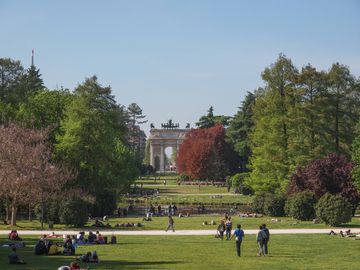

The Sempione Park is Milan's biggest city park with an area of 386,000 square meters. It takes its name from the Sempione Road, a road that once was part of a corridor constructed by Napoleon that ran through the Alps to connect Milan to Paris. Today it is fenced all around, offers free Wi-Fi connection and has more surveillance cameras than trees.
There has been a park in this part of town since the days of the Visconti Dynasty and the construction of the first castle in the 14th century. It was known as the "Barcho" and was then enlarged by the Sforza rulers to the point of encompassing a 3-million square meter area. At that stage it was still mainly a forest with oak and chestnut trees, but it also had several species of exotic animals that had been brought by the city's authorities.
After the rule of the Sforza, the Spanish turned the area immediately behind the castle into a parade ground, while the remainder 2.5 million square meters were destined for agriculture. In the beginning of the 19th century Napoleon, after having conquered Milan from the Austrians, transformed most of that area into a city park. It was delineated by the castle in the southeast, the Arena in the northeast and by the Arch of Peace in the northwest.
It was architect Cesare Beruto who in 1884, after the Unification of Italy, reorganized the entire city and gave the Sempione Park more or less the shape and dimensions that it has today. He also convinced the city authorities to abandon the castle as a military barracks and dedicate it to cultural use. Thanks to him the area around the park, as well as the city center, obtained the civil character we see today.
The park's design was the work of Emilio Alemagna, who modeled it after the English landscape gardens. He conceived the paths, the pond and the belvedere, on which stands the Sempione Park Library. The park was constructed between 1888 and 1893. In the 20th century it was subjected to a series of minor enlargements and modernization projects, but most of it has not changed since its inauguration.
The Milanese have always loved this park, not only because it provides them with a spacious area to relax outdoors, but because it has also been associated with numerous international commercial and cultural initiatives that have made Milan one of the world's leading financial cities. In 1894 the park hosted the Reunited Expositions, an international trade fair. In 1906 the park welcomed the International Exposition, which was even bigger than the preceding one, including fine arts, engineering and industrial exhibitions. It took place in the two-story, liberty-style aquarium. In 1933 architect Giovanni Muzio built the Palazzo dell'Arte, which today is used for the Milan Triennale, a museum dedicated to design, fashion, architecture, urban planning, media arts, music and the role of industry in art.
Other important structures in the park include the Arena Civica, constructed in the beginning of the 19th century and used for just about every possible athletic competition. Since 2010 it has been the headquarters of Milan's rugby team. In the northwest side of the park there is also the Torre Branca, an iron panoramic tower, from which you can see not only all the roofs of the city, but also the Alps on the border between Italy and Switzerland. It is the seventh highest structure in Milan with a height of 108.6 meters.
Amongst the trees cultivated on the park's territory we can find the Sycamore, the Pine, the Beech, the Maple, the Caucasian Walnut, the Oak, the Bald Cypress, the Large-Leaved Linden and others. If you are tired after a busy day of shopping and high profile meetings, the Sempione Park is a perfect place to unwind and immerse yourself, albeit very fleetingly, into nature.